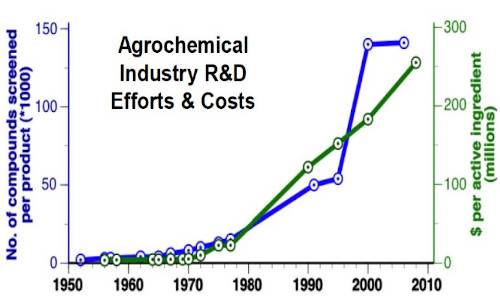By Kelly Seuhs
For alfalfa producers, damage by alfalfa weevil threatens both short- and long-term economic goals. Defoliation, reduced yield and quality are immediate concerns. In addition, loss of yield in the current crop, inhibition of growth in subsequent cuttings, increased susceptibility to disease and early weed encroachment can further decrease stand life.
Insecticide resistance has become a major issue in many alfalfa producing states. Field research trials and laboratory bioassays in Oklahoma have indicated varying degrees of
alfalfa weevil resistance to conventional pyrethroid insecticides, especially those containing lambda-cyhalothrin. Several products are available in Oklahoma for alfalfa
weevil control; however, modes of action (MoA) are limited (Table 1).
Development of new insecticide products and increasing costs in testing and regulation of these products make it essential to preserve and extend the life of each MoA through integrated resistance management (IRM) programs. Understanding the principles of resistance management is crucial in helping growers and certified crop advisors proactively manage alfalfa weevil populations.
The number of compounds screened by the chemical industry just to find and commercialize one product continues to escalate (Figure 1). These issues along with the ever-present threat of resistance make developing IRM programs even more challenging.
Figure 1. Research and development costs associated with bringing new products to market. Adapted from Sparks, Pesticide Biochem. Phys. (Pier et al, 2015).

An Integrated Approach to IRM
The most effective plan to combat alfalfa weevil insecticide resistance is to incorporate as many strategies as feasible to prevent it from occurring. When working toward this goal, incorporation of an Integrated Resistance Management (IRM) program in conjunction with a comprehensive IPM approach is recommended. This type of system covers three basic components: monitoring pest complexes in the field for changes in population survival, focusing on economic thresholds and integrating multiple control strategies.
Table 1. Major chemistries listed for alfalfa weevil control in Oklahoma.
| Name and Group # | Active Ingredient | Example Products |
|---|
Sodium channel Modulators Pyrethroids (3A) | Lambda-cyhalothrin Cyfluthrin Permethrin Gamma-cyhalothrin Zeta-cypermethrin | Warrior (Many generics e.g., Silencer, Paradigm, Grizzly). Baythroid Pounce Proaxis Mustang-Max |
|---|
Acetylcholinesterase (AChE) Inhibitors Carbamates and Organophosphates (1A&B) | Methomyl (1A) Carbaryl (1A) Malathion (1B) Chlorpyrifos (1B) | Lannate Sevin Malathion Lorsban (Many generics e.g., Eraser, Govern, Hatchet, Pilot) |
|---|
Voltage-dependant sodium channel blockers | Indoxacarb | Steward |
|---|
Monitoring
Scouting is a fundamental strategy for any IPM program. Insect identification and determination of population density are crucial for a successful integrated plan. Research-based sampling procedures are used to determine if pesticides are justified and necessary.
Economic Thresholds
Insecticides should be used only if insects are numerous enough they begin to approach economic losses exceeding the cost of the insecticide plus application (economic threshold). Producers are encouraged to consult their local advisors or Extension specialist about economic thresholds of target pests in their areas.
Integrated Control Strategies
Alfalfa growers and crop consultants should incorporate as many IPM strategies as possible including the effects of beneficial insects, cultural controls, pest-resistant varieties, mechanical approaches and insecticides when needed.
- Applications of insecticides must be timed correctly and target the most vulnerable life stages of insect pests and the crop. It is critical that producers follow spray rates and application intervals recommended by manufacturers label and in compliance with local agricultural regulations. Scouting is a must.
- It is important to mix and apply insecticides accurately.
- A key element of effective resistance management is the use of insecticide rotations or sequences of different insecticide mode of action classes. By rotating insecticide mode of action within the same crop cycle or year after year, producers help in selecting for resistance or cross-resistance.
- It is important to consider the impact of pesticides on beneficial insects and use products at labeled rates and spray intervals to minimize undesired effects on parasitoids and predators that attack a wide range of potential pests.
- Another management option is preservation of susceptible population of pests. Some programs try to preserve susceptible individuals within the target population by providing a refuge for susceptible insects. These susceptible individuals may out-compete and interbreed with resistant individuals, which dilutes the impact of any resistance that may have been selected.
- Consider crop residue options. Late-season harvesting or grazing (after a hard freeze) can deprive alfalfa weevils of overwintering egg deposition sites and reduce spring weevil occurrence.
With continued importance of insecticides as a control measure, alfalfa weevil insecticide resistance will continue to occur. Utilizing an integrated resistance management plan allows growers to be proactive in delaying and managing resistance.
Source : okstate.edu